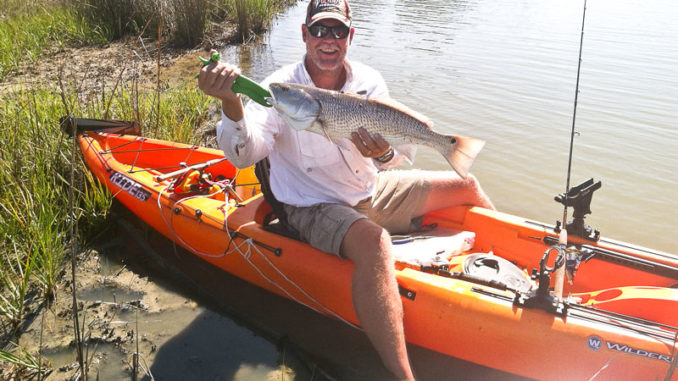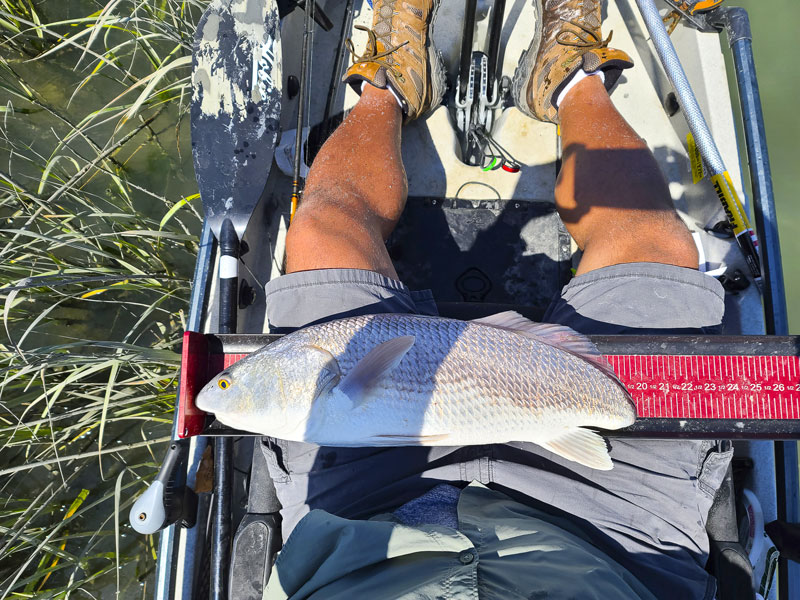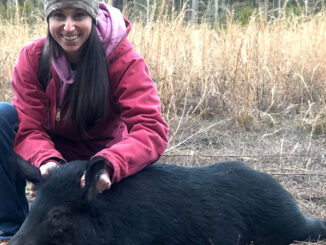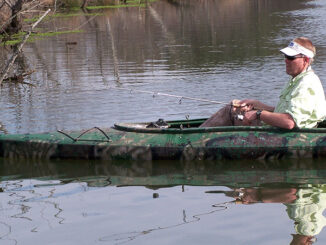
August’s full moon brings on high-water opportunities for kayakers
August can be a tough month for a lot of inshore species due to high water temperatures, but it also offers some great opportunities to sight-fish for redfish in a lot of areas across the Carolinas.
Known by redfish fanatics as “tailing tides,” the August full moon is called the sturgeon moon, after North America’s largest fish, the lake sturgeon; it might as well be named the redfish moon.
In fact, this August starts out on with a building full moon, which officially appears Aug. 3. Anglers can expect higher than normal tides to flood dry areas of the marsh, making those areas appealing to redfish and kayakers.
Prior local knowledge is key to finding and fishing flooded flats. Some areas of the Carolinas may flood with as little as 4 ½ feet of tide, while areas further south may need 8 feet or more.
Food is first
The appeal for redfish is food. Fiddler crabs make their holes in sandy areas above the normal tidal reach in the marsh. And they will hide in those holes as the water encroaches. Redfish, in turn, file in and ferret the crabs out by rooting in the grass and sand.
The appeal to the kayak angler is the same basic appeal of a lot of plastic boat fishing: access to areas not accessible to others. Even the shallowest flats boat can’t go where a kayak can. Especially when porting and pulling the boat over sandbars to reach the areas beyond.
Prevailing winds are also a consideration, especially the further north you go in the Carolinas. Ideally, you want a wind that will push water onto the flat you’ll be fishing and not sucking it out.
Be there on time for tailing redfish
Timing is everything when fishing flooded flats. The best window may only be an hour or two at best. So it’s important to have you, your boat and gear prepared, and be sitting on the edge of the flat you want to fish before the water comes up.
Unlike a flats boat where one angler poles and one fishes, a kayak angler does the work and reaps the rewards.
Fly fishing is king when fishing flooded flats for redfish. Anglers choose 8-weight rods, floating lines and crab-imitating fly patterns to entice redfish into taking the bait. It’s also not uncommon for anglers to use spinning and even baitcasting gear on flooded flats. Soft plastics and subtle surface or sub-surface baits fill the bill.
Be careful
Regardless of the tackle used, stealth is paramount when fishing flooded flats. This is another advantage of approaching via kayak. Anglers typically look for redfish tails gently waving at or even above the surface, hence the moniker “tailing tides.” As a fish’s head goes down into the marsh bottom, the tail rises and waves as the redfish push their noses into the mud, sucking out crabs.
Don’t expect redfish to see baits as well as they might when fishing a school or even an individual fish swimming in more open water. The best presentations will be just ahead of the fish’s path, but not on top of working fish.
It can be maddening to work into position, perfectly place a bait and have the fish ignore or miss it because he was rooting face down in the mud.
Tailing redfish? No-tail redfish!
Chase Fuchs of Conway, S.C., has one of the best fish stories when it comes to redfish. This past May, he was fishing alone near Murrells Inlet, in the marsh behind Huntington Beach State Park. Hoping to catch a flounder as part of a month-long competition with the Pee Dee Kayak Anglers, Fuchs was doing his best to catch a flatfish from his Hobie Pro Angler 14 when his first redfish ever showed up.
“Earlier in the day, I had scooped up a blue crab and put him in the cooler for bait,” he said. “I had been out fishing for several hours and was waiting for high tide to see if that would turn the fish on. I busted up the crab and was soaking it under a cork while I worked casting another rod.”
After about 5 minutes, when he decided to check the crab and reposition it, he thought he was hung on some oyster shells.
“The cork never moved, and I pulled up and thought I was hung,” Fuchs said. “That’s when I felt something heavy on the end of the line. It didn’t make a long run, but it just kept diving, trying to get back on the bottom.”
Slot-sized fish would have been over-the-slot
After an impressive struggle, Fuchs landed a 20-inch redfish. The only problem was, the fish was missing its entire tail from just past the anal and dorsal fins back.
“The photos don’t do it justice for it’s size, because it was really thick,” he said. “I didn’t weigh him but I’m sure he’d go 10 pounds.”
Fuchs said the missing tail appeared to be a long-healed injury, possible from being grabbed by a dolphin or a shark. The wound had completely healed over.
Although the fish would have fit inside the legal harvest slot limit in South Carolina of 15 to 23 inches, Fuchs decided to release it.
“I figured he’d already had a tough life, but he was apparently making it just fine without a tail,” he said. “He would easily have been over the slot if his tail wasn’t missing.”
Talk about a great fish to catch in a redfish tournament, Fuchs’ redfish won’t have to worry about giving away his location on a tailing flat.

Best bets
NORTH CAROLINA
WHAT — Redfish
WHERE — Bear Island marshes near Swansboro
HOW — Fly fishing is preferred in the shallow marsh.
LAUNCH — An N.C. Wildlife Resources Commission ramp in Cedar point, or Shell Rock Landing in Hubert.
INSIDER TIP — If fly fishing, use as light a line as you think you can get away with. Many times, with everything in order, redfish will still spook simply due to the line falling near them
SOUTH CAROLINA
WHAT — Redfish
WHERE — Beaufort County
HOW — If you’re not a fly fisherman, casting a scented Z-Man Crab rigged weedless and weightless will get the job done.
LAUNCH — Public launches on the south end of the ACE Basin are few and far between, but kayak road access is not bad. Google Maps and satellite are your best planning tools.
INSIDER TIP — Typical flood tides in Beaufort County run from 7.8 to 9 feet, which allows a little longer fishing window than most places.





Be the first to comment